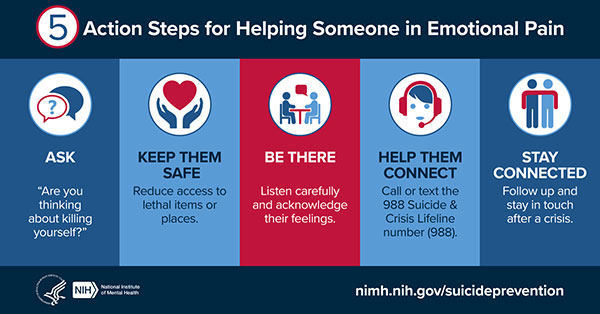

If you or someone you know is in crisis
Call or text the 988 Suicide & Crisis Lifeline at 988 (para ayuda en español, llame al 988). The Lifeline provides 24-hour, confidential support to anyone in suicidal crisis or emotional distress. Call 911 in life-threatening situations. If you are worried about a friend’s social media updates, you can contact safety teams at the social media company . They will reach out to connect the person with the help they need.
What is suicide?
Suicide is a major public health concern. In 2021, suicide was the 11th leading cause of death overall, claiming the lives of over 48,100 people. Suicide is complicated and tragic, but it is often preventable. Knowing the warning signs for suicide and how to get help can help save lives.
Suicide is when people harm themselves with the intent of ending their life, and they die as a result.
A suicide attempt is when people harm themselves with the intent of ending their life, but they do not die.
Avoid using terms such as “committing suicide,” “successful suicide,” or “failed suicide” when referring to suicide and suicide attempts, as these terms often carry negative meanings.
What are the warning signs of suicide?
Warning signs that someone may be at immediate risk for attempting suicide include:
- Talking about wanting to die or wanting to kill themselves
- Talking about feeling empty or hopeless or having no reason to live
- Talking about feeling trapped or feeling that there are no solutions
- Feeling unbearable emotional or physical pain
- Talking about being a burden to others
- Withdrawing from family and friends
- Giving away important possessions
- Saying goodbye to friends and family
- Putting affairs in order, such as making a will
- Taking great risks that could lead to death, such as driving extremely fast
- Talking or thinking about death often
Other serious warning signs that someone may be at risk for attempting suicide include:
- Displaying extreme mood swings, suddenly changing from very sad to very calm or happy
- Making a plan or looking for ways to kill themselves, such as searching for lethal methods online, stockpiling pills, or buying a gun
- Talking about feeling great guilt or shame
- Using alcohol or drugs more often
- Acting anxious or agitated
- Changing eating or sleeping habits
- Showing rage or talking about seeking revenge
Suicide is not a normal response to stress. Suicidal thoughts or actions are a sign of extreme distress and should not be ignored.. If these warning signs apply to you or someone you know, get help as soon as possible, particularly if the behavior is new or has increased recently.
Here are five steps you can take to #BeThe1To help someone in emotional pain:

- ASK: “Are you thinking about killing yourself?” It’s not an easy question, but studies show that asking at-risk individuals if they are suicidal does not increase suicides or suicidal thoughts.
- KEEP THEM SAFE: Reducing a suicidal person’s access to highly lethal items or places is an important part of suicide prevention. While this is not always easy, asking if the at-risk person has a plan and removing or disabling the lethal means can make a difference.
- BE THERE: Listen carefully and learn what the individual is thinking and feeling. Research suggests acknowledging and talking about suicide may reduce rather than increase suicidal thoughts.
- HELP THEM CONNECT: Save the 988 Suicide & Crisis Lifeline number (call or text 988) in your phone so they’re there if you need them. You can also help make a connection with a trusted individual like a family member, friend, spiritual advisor, or mental health professional.
- STAY CONNECTED: Staying in touch after a crisis or after being discharged from care can make a difference. Studies have shown the number of suicide deaths goes down when someone follows up with the at-risk person.
Risk Factors
Researchers are finding that both genetic and environmental factors contribute to the risk of developing an anxiety disorder.
The risk factors for each type of anxiety disorder vary. However, some general risk factors include:
- Shyness or feeling distressed or nervous in new situations in childhood
- Exposure to stressful and negative life or environmental events
- A history of anxiety or other mental disorders in biological relatives
Anxiety symptoms can be produced or aggravated by:
- Some physical health conditions, such as thyroid problems or heart arrhythmia
- Caffeine or other substances/medications
If you think you may have an anxiety disorder, getting a physical examination from a health care provider may help them diagnose your symptoms and find the right treatment.
Treatment
Effective, evidence-based interventions are available to help people who are at risk for suicide.
Brief interventions
- Safety planning: Personalized safety planning has been shown to help reduce suicidal thoughts and actions. Patients work with a health care provider to develop a plan that describes ways to limit access to lethal means such as firearms, pills, or poisons. The plan also lists coping strategies and people and resources that can help in a crisis.
- Follow-up phone calls: Research has shown that when at-risk patients receive supportive phone calls for further risk monitoring and are encouraged to engage in safe behaviors and seek help, their suicide risk goes down .
Psychotherapies
Multiple types of psychosocial interventions have been found to help individuals who have attempted suicide (see below). These types of interventions may prevent someone from making another attempt.
- Cognitive behavioral therapy (CBT) can help people learn new ways of dealing with stressful experiences. CBT helps individuals recognize their thought patterns and consider alternative actions when thoughts of suicide arise .
- Dialectical behavior therapy (DBT) has been shown to reduce suicidal behavior in adolescents. DBT has also been shown to reduce the risk of suicide attempts in adults with borderline personality disorder , a mental illness characterized by an ongoing pattern of varying moods, self-image, and behavior that often results in impulsive actions and problems in relationships. A therapist trained in DBT can help a person recognize when their feelings or actions become overwhelming and teach the person skills that can help them cope more effectively with upsetting situations.
Medication
Some individuals at risk for suicide might benefit from medication. People can work with their health care providers to find the best medication or medication combination, as well as the right dose. Many people at risk for suicide often have a mental illness or substance use problems and may benefit from medication along with psychosocial intervention.
Clozapine is an antipsychotic medication used primarily to treat individuals with schizophrenia. To date, it is the only medication with a specific U.S. Food and Drug Administration (FDA) indication for reducing the risk of recurrent suicidal behavior in patients with schizophrenia or schizoaffective disorder.
If you are prescribed a medication, be sure you:
- Talk with a health care provider to make sure you understand the risks and benefits of the medications you’re taking.
- Do not stop taking a medication without talking to your health care provider first. Suddenly stopping a medication may lead to worsening of symptoms. Other uncomfortable or potentially dangerous withdrawal effects also are possible.
- Report any concerns about side effects to a health care provider right away. They can help determine whether you need a change in the dose or a different medication.
- Report serious side effects to the FDA MedWatch Adverse Event Reporting program online or by phone at 1-800-332-1088. You or your health care provider may send a report.
To find the latest information about medications, talk to a health care provider and visit the FDA website .
Collaborative care
Collaborative care is a team-based approach to mental health care. A behavioral health care manager will work with the person, their primary health care provider, and mental health specialists to develop a treatment plan. Collaborative care has been shown to be an effective way to treat depression and reduce suicidal thoughts.
Reference
Webpage
- National Institute of Mental Health. Suicide Prevention. U.S. Department of Health and Human Services, National Institutes of Health. Retrieved April 22, 2024 from https://www.nimh.nih.gov/health/topics/suicide-prevention

